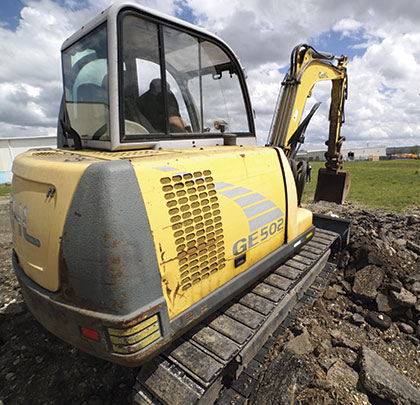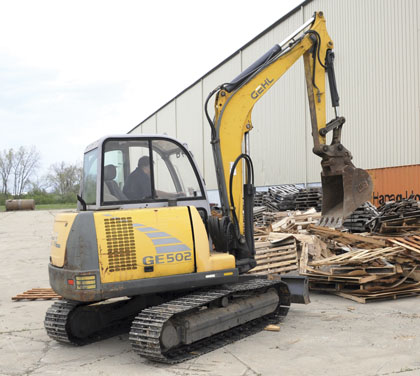Over the last three decades, there has been a dramatic shift in the sizes and types of machinery used in the construction industry—larger machines have made way for compact equipment. The decrease in load capacity has more than been made up for with faster cycle times and less disruption to the surrounding area.
While many compact machines, like the skid-steer loader and compact track loader, are unique from larger machines, the compact excavator is often looked at as a scaled down version of larger units. Compact and larger excavators may look the same, but there has been one characteristic that manufacturers have overlooked for years—steel tracks were eliminated from these compact machines in favor of rubber ones. Perhaps it’s because early manufacturers had their own ideas about the type of work compact excavators were best suited for or to keep manufacturing costs down.
Whatever the reasoning, rubber tracks have become the norm for compact excavators while you, the contractor, have continued to push the limits of these small machines and used them to perform work that manufacturers could have never thought of. For some of these applications, rubber tracks are a good fit, but in others, the strength and durability of steel tracks certainly would be beneficial. Luckily, a few manufacturers and aftermarket suppliers are finally catching on, and you now have more track options to choose from for your compact excavators.
Today, you can choose from rubber, steel, rubber track pads, and hybrid systems for your compact excavator. Each system has unique advantages over the others, depending on the type of work you do. So, before you replace a set of worn tracks or purchase a new machine with the standard OEM track configuration, take a moment to understand your options.
RUBBER TRACK SYSTEMS
Let’s start by looking at the rubber tracks that most compact excavators are outfitted with today. Rubber tracks are lighter than steel, which means an excavator leaves less of an impression when traveling over grass. Rubber is also the best option when traveling over hard surfaces, like concrete or asphalt. However, harsh ground conditions and demanding applications, like demolition work, can quickly destroy a set of rubber tracks. Also, many contractors prefer a more weighted compact excavator; they say it improves the machine’s breakout force and stability.

Featured Image: Hybrid tracks use a combination of heavy-duty steel chains with bolt-on hybrid pads.
Above: Steel tracks will last a long time and will hold up to the harshest ground conditions and applications.
STEEL TRACK SYSTEMS
One of the main reasons why you don’t see rubber tracks on larger equipment is durability. Steel lasts a long time and will hold up to the harshest ground conditions and applications. A steel track system also has better traction than rubber for better backfilling performance. And, that added productivity does not come at the expense of flotation. Steel is very comparable to rubber tracks in that area.
As one of the largest distributors of aftermarket compact excavator tracks, MWE has seen a significant increase in the demand for steel tracks, in particular on the larger end of the compact segment, starting at 10,000 lbs. Those machines are used in demolition, dirt work, and on snow and ice. In these environments, you’ll get better performance with a set of steel tracks and can reduce track replacement costs.
Of course, if the type of work you do varies from hard surfaces, turf, and dirt, steel tracks will not be the right choice for you. However, you do have the option of using rubber track pads in these situations, or you may want to consider a hybrid system.
RUBBER TRACK PADS
Rubber track pads are designed to work on a steel track system and will either clip-on or bolt-on to each steel grouser. And, they can be quickly added or removed from the machine depending on the environment.
The decision to go with bolt-on or clip-on pads will depend on what type of steel tracks you currently have on your machine and personal preference. If your machine has predrilled holes for the pads, and most do, bolt-on pads are a great option if you plan to be using the pads for an extended period. Clip-on pads will work virtually with any steel track system without having to make any modifications.
HYBRID TRACK SYSTEM
Hybrid track system combines the durability of steel tracks with the versatility of rubber tracks. Hybrid tracks use a combination of heavy-duty steel chains with bolt-on hybrid pads. The pads are a combination of steel grousers and rubber pads molded into one integrated part and bolts directly to the chain. If a pad is damaged, it can easily be swapped out with a new pad—you can’t do that with a traditional rubber track. Also, the design of a hybrid system doesn’t require the rubber to flex like a rubber track, so harder rubber can be used for the pads, which will hold up better on hard surfaces and environments with jagged debris.
Like steel, a hybrid system can do more damage to turf than rubber tracks because there are gaps between each grouser, which can leave impressions on sensitive surfaces.
MAKING THE SWITCH
There are a lot of great track options available for your compact excavator. Taking the time to understand each of these options and upgrading to a track system that matches your specific needs can increase the productivity of your compact excavator and reduce your track replacement expenses.
PRICING DIFFERENCE
If you compare and decide to make the switch to steel tracks or a hybrid track system, you can expect to pay around the same price for steel tracks as what you would for rubber tracks. While, hybrid systems will run about 20 percent more than rubber tracks. ■
About the Author:
Greg Hawthorne is general sales manager at Midwest Equipment (MWE), a manufacturer and distributor of compact equipment tracks and tires. For more information, visit www.tracksandtires.com.
_________________________________________________________________________
Modern Contractor Solutions, November 2016
Did you enjoy this article?
Subscribe to the FREE Digital Edition of Modern Contractor Solutions magazine.




